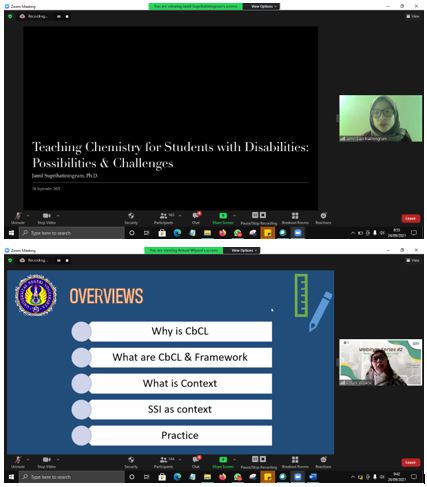 Bahasa Indonesia
Bahasa Indonesia English
English
You are here
Webinar Series #2: Chemistry Education Department, 2021

Friday, September 24, 2021, Webinar Series #2 of Chemistry Education Department has been held. A total of 185 participants took part in the Webinar Series #2 online via Zoom Meeting. On this occasion, the event was opened by the Head of the Department of Chemistry Education, FMIPA UNY, Dr. Retno Arianingrum. Based on his remarks, the Webinar Series #2 activity really supports student insight with an occupational profile as a practitioner in the field of education, more broadly it can help learning chemistry for students with disabilities.
Speech delivered by Dr. Retno Arianiningrum, relevant to the material presented by the speakers.This Webinar Series #2 presents Dr. Jamil Suprihatiningrum, a lecturer in Chemistry Education at UIN Sunan Kalijaga, Yogyakarta, Indonesia, with an area of expertise in Inclusive Science Education. On this occasion Dr. Jamil delivered a material entitled 'Teaching Chemistry for Students with Disabilities: Possibilities & Challenges'. Referring to Article 4 Paragraph 1 of Law Number 8 of 2016 concerning Persons with Disabilities, they are grouped into four groups, namely: physical, intellectual, mental, and sensory. The disability with a high incidence such as intellectual disability or emotional and behavioral disorders and low incidence disabilities such as blindness, deafness, deaf-blindness, hereinafter referred to as students with disabilities (SWD). Science/chemistry teachers are required to create a positive and caring learning environment by modeling sensitivity to differences and using a variety of instructional approaches and interaction styles to teach SWD in the classroom. This is because the acceptance of SWD learning is one of the important factors that teachers must understand. The teacher can identify what strengths or strengths SWD has. The difference in conditions between SWD can be facilitated by the teacher by designing teaching methods, so that there is a modification specification as a result of a study of abilities and relatively different time for each SWD to practice working on questions. Teachers can use technology to help SWD learn, such as audio, braille, or visual technology.
The second speaker is Dr. Antuni Wiyarsi, a lecturer in Chemistry Education, Faculty of Mathematics and Natural Sciences, UNY, specializing in Socio-Scientific Issues. In this Webinar Series #2 he delivered material on 'Using Socio-Scientific Issues in The Context-based Chemistry Learning (CbCL)'. Based on the presentation of Dr. Antuni, the selection of the right context is very important for CbCL to really increase students' interest and perception of the relevance of SSI. This supports the socio-cultural perspective of science/chemistry education. The SSI has several dimensions related to the dimensions of the relevance of science so as to support students' scientific literacy. The SSI is in the context of relevant issues and depends on culture, society, and national/society characteristics on the economic, political, religious, ethical, environmental, health, scientific, technological, societal, moral dimensions. As an example of SSI as a context, the issue of coral reefs as a maritime nation phenomenon, manifests around the world in different ways from resources and damage, thereby driving environmental behavior that dictates what actions they take. This will lead students to special topics such as: Acid-base pH, chemical equilibrium, elemental chemistry, minerals in the sea, marine organisms, and coral growth.
Chemical education students in undergraduate and master's programs actively participate as participants. This participation can be seen in the question and answer discussion with the resource persons. With the implementation of the Webinar Series #2 activity, it is expected to be able to add insight and motivation for students as prospective teachers to develop their knowledge that supports graduate skill competencies.
Sistem Informasi
Kontak Kami
Program Studi Pendidikan Kimia
FMIPA Universitas Negeri Yogyakarta
Gedung Dekanat D.07 FMIPA UNY
Kampus Karangmalang Yogyakarta 55281
Telp. (0274)586168 Pes. 115
Email: pend_kimia@uny.ac.id
Copyright © 2024,
